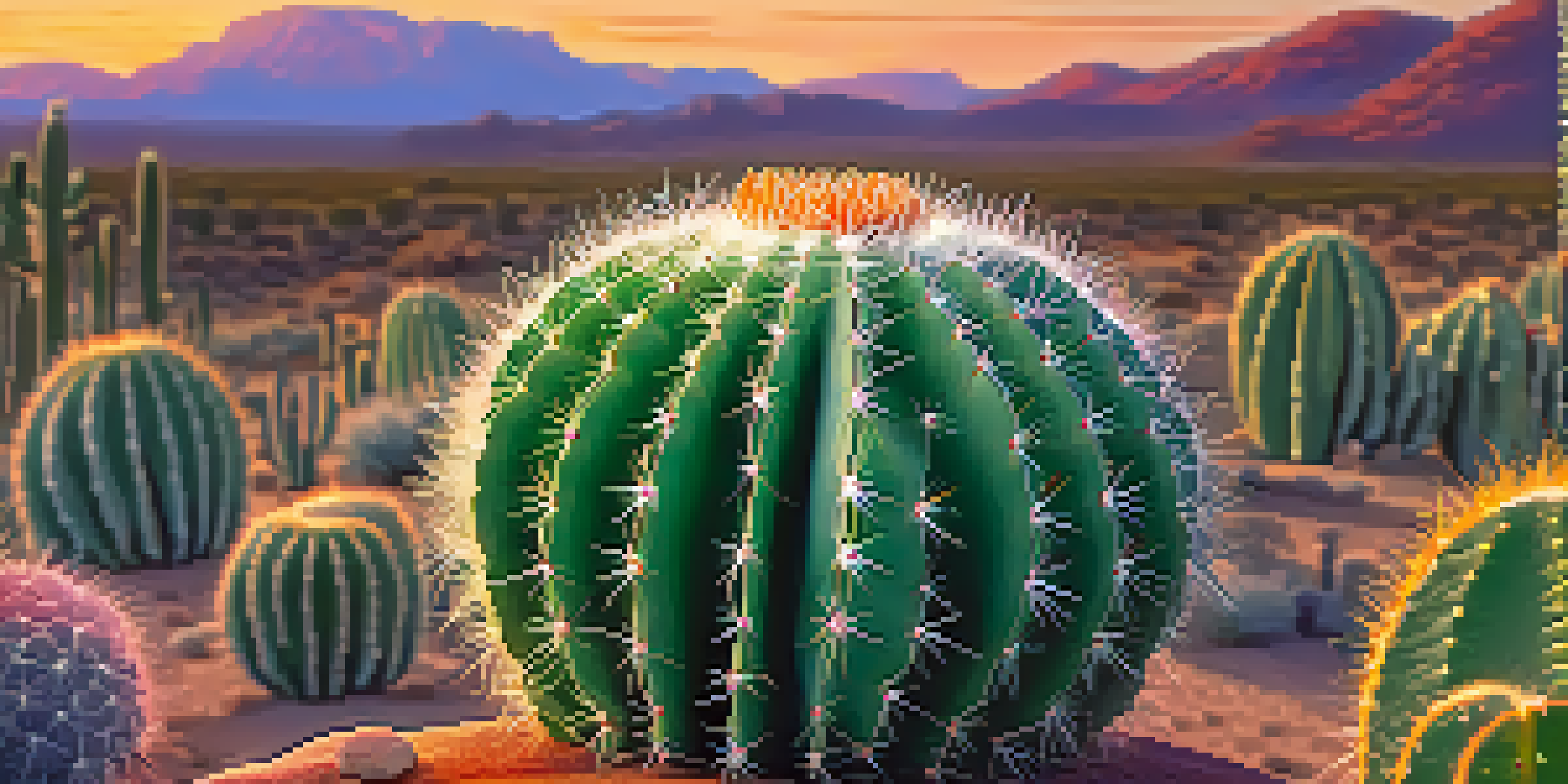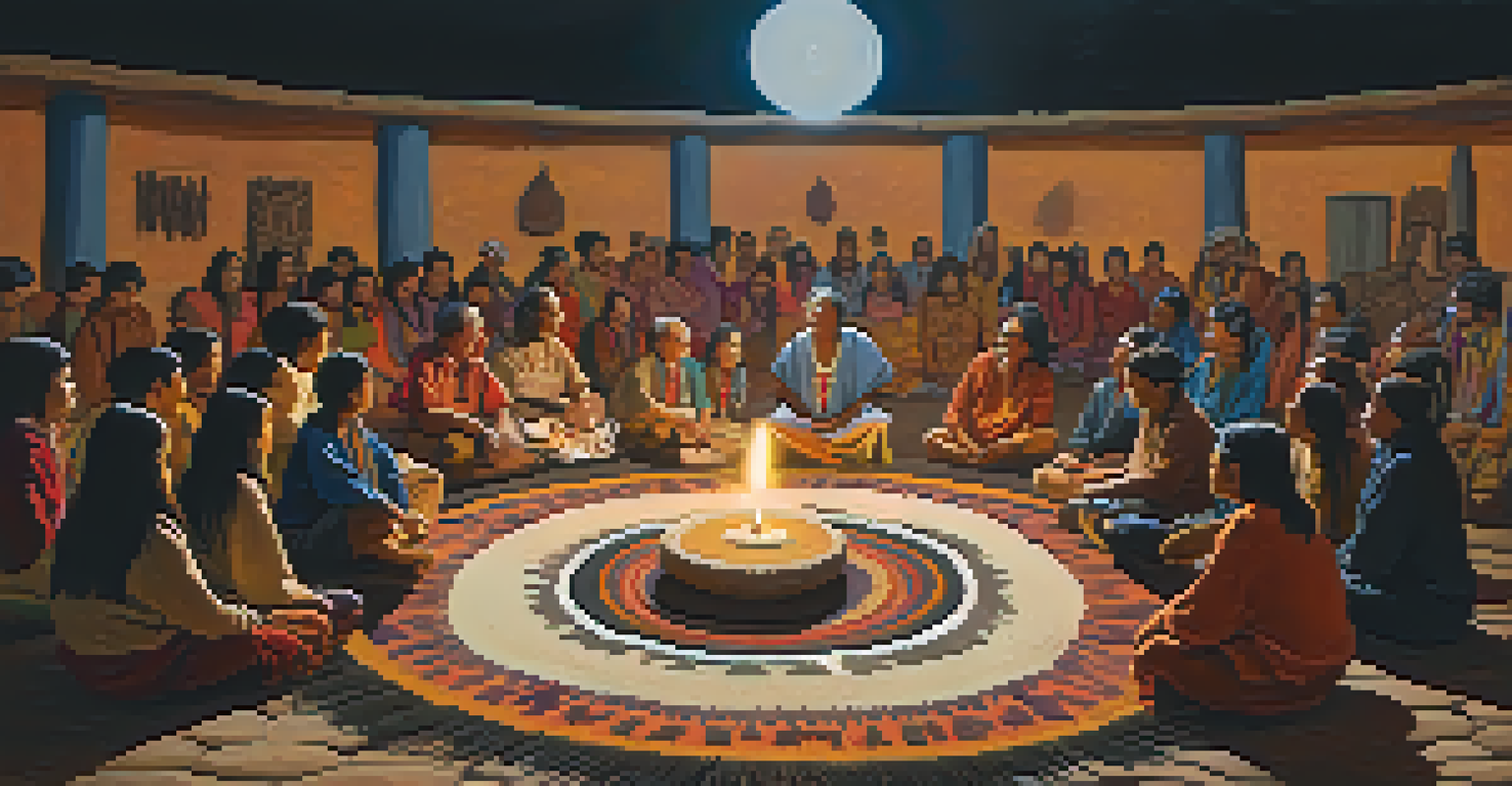Cultural Significance of Peyote in Shamanic Practices

Understanding Peyote: A Brief Overview
Peyote, a small cactus native to northern Mexico and southern Texas, has been used for thousands of years in various spiritual practices. Known scientifically as Lophophora williamsii, this plant contains mescaline, a psychoactive compound that induces profound alterations in consciousness. For many Indigenous cultures, peyote is not just a plant; it’s a sacred tool for healing and spiritual connection.
The sacred plant is a tool for healing, a way to connect with the divine and with our own inner wisdom.
Traditionally, peyote is consumed during ceremonial rituals, where its effects are believed to facilitate communication with the spiritual realm. The use of this cactus is deeply embedded in the cultural narratives of several Native American tribes, such as the Huichol and the Navajo. By understanding the significance of peyote, we can appreciate the deep-rooted traditions and spiritual beliefs surrounding its use.
From a broader perspective, peyote serves as a symbol of resilience and cultural identity for Indigenous peoples. Its use has faced various legal and societal challenges, yet many communities continue to uphold its sacred status. This enduring connection to peyote illustrates the importance of preserving cultural practices in the face of modernization.
The Role of Peyote in Shamanic Rituals
In shamanic practices, peyote is often employed as a catalyst for spiritual journeys and healing ceremonies. Shamans, who act as mediators between the physical and spiritual worlds, use peyote to enhance their intuitive abilities and access higher states of consciousness. This relationship highlights the plant's role in facilitating personal and communal healing.

During these rituals, participants may engage in singing, drumming, and storytelling, creating a sacred space for introspection and connection. The peyote experience can lead to vivid visions and insights, helping individuals confront personal challenges or gain clarity on their life paths. This transformative process underscores the importance of the ceremonial context in which peyote is consumed.
Peyote's Cultural Significance
Peyote serves as a sacred tool for healing and spiritual connection among Indigenous cultures, embodying resilience and cultural identity.
Moreover, the communal aspect of these rituals fosters a sense of belonging and shared purpose among participants. By coming together in this way, individuals can support one another in their spiritual journeys, reinforcing social bonds and cultural traditions. This communal healing aspect is just as significant as the individual experiences that peyote may induce.
Cultural Identity and Heritage Preservation
The use of peyote is intricately linked to the cultural identity of many Indigenous communities. For these groups, peyote ceremonies are not merely spiritual practices; they are essential expressions of their heritage and worldview. This connection to peyote highlights the importance of preserving traditional practices in a rapidly changing world.
Psychedelics can help us understand ourselves and the world; they can be a bridge to the spiritual.
As globalization increases, Indigenous communities face the challenge of maintaining their cultural identities while navigating modern influences. Peyote serves as a symbol of resistance against cultural erasure, embodying the strength and resilience of these communities. Engaging with peyote rituals allows new generations to connect with their ancestors and traditions.
Preservation efforts often involve educating both Indigenous and non-Indigenous people about the significance of peyote. This awareness can help build respect for the cultural practices surrounding peyote and promote greater understanding of Indigenous rights. By valuing these traditions, we contribute to a more equitable society that honors diverse cultural heritages.
Scientific Research on Peyote and Its Effects
In recent years, scientific research has begun to explore the effects of peyote and its active compound, mescaline, on mental health. Studies have indicated that peyote may help alleviate symptoms of anxiety, depression, and PTSD in some individuals. This growing body of research is sparking interest in the therapeutic potential of peyote, especially within the context of mental health treatment.
While many Indigenous cultures have long recognized the healing properties of peyote, scientific validation adds a layer of credibility to these ancient practices. Understanding how peyote interacts with the brain can provide insights into the mechanisms behind its psychological effects. This knowledge may lead to greater acceptance and integration of peyote in modern therapeutic settings.
Scientific Research on Peyote
Recent studies suggest that peyote may alleviate symptoms of anxiety, depression, and PTSD, highlighting its therapeutic potential.
However, it’s crucial to approach this research with sensitivity and respect for Indigenous cultures. The commodification of peyote should be avoided, and any therapeutic applications must honor the traditional uses and meanings of the plant. Collaborative efforts between researchers and Indigenous communities can ensure that the cultural significance of peyote is preserved while exploring its scientific potential.
Legal Challenges and Cultural Rights
The legal status of peyote varies significantly across different regions, often reflecting broader societal attitudes toward Indigenous practices. In some areas, the use of peyote is protected for religious purposes, allowing Indigenous groups to continue their rituals without legal repercussions. However, in other regions, peyote remains criminalized, leading to ongoing struggles for cultural rights.
These legal challenges not only threaten the continuation of peyote practices but also impact the identities of Indigenous communities. When access to sacred plants is restricted, it undermines the ability of these groups to maintain their cultural heritage. Advocacy for legal protections is essential to ensure that these communities can freely engage in their traditional practices.
Furthermore, discussions about the legal status of peyote should encompass the broader context of Indigenous rights and sovereignty. Recognizing the significance of peyote as a cultural and spiritual resource is vital for fostering respect and understanding. As society continues to evolve, it’s important to engage in conversations about cultural preservation and the rights of Indigenous peoples.
Peyote in Contemporary Spiritual Practices
In recent years, there has been a resurgence of interest in peyote among modern spiritual seekers and practitioners. Many individuals, drawn by the promise of personal growth and enlightenment, seek out peyote ceremonies as a means of exploring their spirituality. This trend raises important questions about the intersection of traditional practices and contemporary spirituality.
While some modern practitioners genuinely seek to honor the sacredness of peyote, others may inadvertently commodify its use. This commodification can lead to misunderstandings about the cultural significance of peyote and its role in Indigenous traditions. It’s important for contemporary seekers to approach peyote with respect and humility, acknowledging its roots in Indigenous cultures.
Legal Challenges for Indigenous Rights
The legal status of peyote varies, impacting the ability of Indigenous communities to maintain their cultural practices and heritage.
Engaging with peyote in a culturally sensitive manner can create opportunities for cross-cultural dialogue and understanding. This exchange can enrich the spiritual journeys of modern practitioners while honoring the traditions of Indigenous peoples. By fostering mutual respect, we can create a more inclusive space for exploring spirituality that acknowledges the wisdom of diverse cultures.
The Future of Peyote and Shamanic Practices
As awareness of peyote’s cultural and therapeutic significance grows, its future remains a topic of discussion within both Indigenous and wider communities. The increasing interest in plant-based healing and shamanic practices presents an opportunity for greater understanding and collaboration. However, it also necessitates careful consideration of the implications for Indigenous cultures.
The future of peyote use will depend on balancing respect for traditional practices with the exploration of its potential benefits in modern contexts. Engaging Indigenous communities in discussions about the future of peyote can help ensure that their voices are heard and that their rights are upheld. This collaborative approach can lead to sustainable practices that honor both cultural heritage and contemporary needs.

Ultimately, the journey of peyote within shamanic practices is a reflection of the ongoing relationship between culture, spirituality, and healing. By fostering respect and understanding, we can ensure that peyote continues to thrive as a sacred plant, enriching the lives of those who honor its significance. The dialogue surrounding peyote and its use will be essential in shaping its future in a way that respects its rich history.